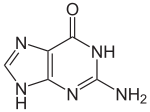Hypoxanthine
Hypoxanthine is a naturally occurring purine derivative. It is occasionally found as a constituent of nucleic acids, where it is present in the anticodon of tRNA in the form of its nucleoside inosine. It has a tautomer known as 6-hydroxypurine. Hypoxanthine is a necessary additive in certain cell, bacteria, and parasite cultures as a substrate and nitrogen source. For example,[1][2] it is commonly a required reagent in malaria parasite cultures, since Plasmodium falciparum requires a source of hypoxanthine for nucleic acid synthesis and energy metabolism.
 | |
| Names | |
|---|---|
| IUPAC name
1H-purin-6(9H)-one | |
| Identifiers | |
3D model (JSmol) |
|
| ChEBI | |
| ChEMBL | |
| ChemSpider | |
| ECHA InfoCard | 100.000.634 |
| KEGG | |
| MeSH | Hypoxanthine |
PubChem CID |
|
| UNII | |
CompTox Dashboard (EPA) |
|
| |
| |
| Properties | |
| C5H4N4O | |
| Molar mass | 136.112 |
Except where otherwise noted, data are given for materials in their standard state (at 25 °C [77 °F], 100 kPa). | |
| Infobox references | |
In August 2011, a report, based on NASA studies with meteorites found on Earth, was published suggesting hypoxanthine and related organic molecules, including the DNA and RNA components adenine and guanine, may have been formed extraterrestrially in outer space.[3][4][5]
The Pheretima aspergillum worm, used in Chinese medicine preparations, contains hypoxanthine.[6]
Reactions
It is one of the products of the action of xanthine oxidase on xanthine. However, more frequently in purine degradation, xanthine is formed from oxidation of hypoxanthine by xanthine oxidoreductase.
Hypoxanthine-guanine phosphoribosyltransferase converts hypoxanthine into IMP in nucleotide salvage.
Hypoxanthine is also a spontaneous deamination product of adenine. Because of its resemblance to guanine, the spontaneous deamination of adenine can lead to an error in DNA transcription/replication, as it base pairs with cytosine. Hypoxanthine is removed from DNA by base excision repair, initiated by N-methylpurine glycosylase (MPG), also known as alkyl adenine glycosylase (Aag). [7]
Additional images
References
- "Estimation of Plasmodium falciparum drug susceptibility by the 3H-hypoxanthine uptake inhibition assay" (PDF). Worldwide Antimalarial Resistance Network. Retrieved 2017-01-20.
- Brockman, A.; Price, R.N.; van Vugt, M.; Heppner, D.G.; Walsh, D.; Sookto, P.; Wimonwattrawatee, T.; Looareesuwan, S.; White, N.J.; Nosten, F. (September 2000). "Plasmodium falciparum antimalarial drug susceptibility on the north-western border of Thailand during five years of extensive use of artesunate-mefloquine". Transactions of the Royal Society of Tropical Medicine and Hygiene. 94 (5): 537–544. doi:10.1016/S0035-9203(00)90080-4. PMC 4340572. PMID 11132385.
- Callahan; Smith, K.E.; Cleaves, H.J.; Ruzica, J.; Stern, J.C.; Glavin, D.P.; House, C.H.; Dworkin, J.P. (11 August 2011). "Carbonaceous meteorites contain a wide range of extraterrestrial nucleobases". Proceedings of the National Academy of Sciences of the United States of America. 108 (34): 13995–13998. doi:10.1073/pnas.1106493108. PMC 3161613. PMID 21836052. Retrieved 2011-08-15.
- Steigerwald, John (8 August 2011). "NASA Researchers: DNA Building Blocks Can Be Made in Space". NASA. Retrieved 2011-08-10.
- ScienceDaily Staff (9 August 2011). "DNA Building Blocks Can Be Made in Space, NASA Evidence Suggests". ScienceDaily. Retrieved 2011-08-09.
- The Pharmacology of Chinese Herbs, Second Edition By Kee C. Huang
- Lee, Chun-Yue (2009). "Recognition and Processing of a New Repertoire of DNA Substrates by Human 3-Methyladenine DNA Glycosylase (AAG)". Biochemistry. 10: 1850–1861. doi:10.1021/bi8018898. PMC 2883313. PMID 19219989.
External links
- Hypoxanthine at the US National Library of Medicine Medical Subject Headings (MeSH)


